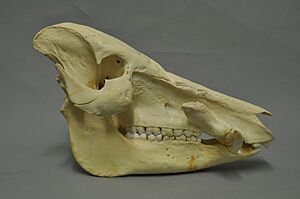Red river hog facts for kids
The red river hog (Potamochoerus porcus) is a wild member of the pig family. It lives in Africa, mostly in the Guinean and Congolian forests. This colorful pig is rarely seen far from rainforests. It usually prefers areas close to rivers or swamps. Sometimes, people also call it a bushpig.
Quick facts for kids Red river hog |
|
|---|---|
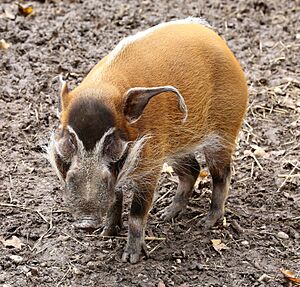 |
|
| Male at Tierpark Hellabrunn in Munich, Germany | |
 |
|
| Female with juvenile at Amneville Zoo in Amnéville, France | |
| Conservation status | |
| Scientific classification | |
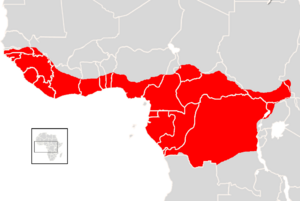 |
|
| Synonyms | |
|
Sus porcus Linnaeus, 1758 |
Contents
What Does the Red River Hog Look Like?
The red river hog has amazing orange to reddish-brown fur. Its legs are black, and it has a white stripe with a tuft of hair along its back. Adult hogs have white marks around their eyes, on their cheeks, and on their jaws. The rest of their snout and face are black.
The fur on their jaw and sides is longer than on their body. Male hogs, called boars, have very noticeable whiskers on their faces. Unlike other pigs in tropical Africa, their whole body is covered in hair. You won't see any bare skin.
Adult red river hogs weigh about 45 to 115 kilograms (100 to 250 pounds). They stand 55 to 80 centimeters (22 to 31 inches) tall. Their body length is about 100 to 145 centimeters (39 to 57 inches). Their thin tail is 30 to 45 centimeters (12 to 18 inches) long and has a black hair tuft at the end.
Their ears are also long and thin. They end in tufts of white or black hair, which can be up to 12 centimeters (4.7 inches) long. Male boars are a bit bigger than females, called sows. Boars have special cone-shaped bumps on each side of their snout. They also have small, sharp tusks. These bony bumps likely help protect the boar's face during fights with other males.
Red river hogs have special scent glands near their eyes and on their feet. Males have more glands near their tusks on the upper jaw. There is also a unique gland about 2 centimeters (0.8 inches) wide on their chin. This gland probably helps them feel things. Female hogs have six teats for feeding their young.
Where Do Red River Hogs Live?
The red river hog lives in rainforests, wet, thick savannas, and forested valleys. They are often found near rivers, lakes, and marshes. These hogs live across a wide area of Africa. Their range goes from the Congo area and Gambia to the eastern Congo. It also extends south to the Kasai and the Congo River.
The exact areas where red river hogs live compared to another type of pig, the bushpig, are not always clear. Generally, the red river hog lives in western and central Africa. The bushpig lives in eastern and southern Africa. Some people think they can breed together where their territories meet, but others disagree. Even though many types of red river hogs have been named in the past, scientists don't recognize any separate types today.
How Do Red River Hogs Behave?
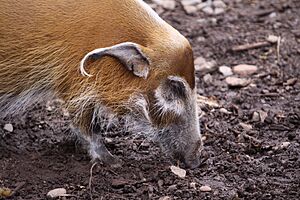
Red river hogs are often active during the day. However, they are mostly active at night or during dawn and dusk. They usually live in small groups of about six to ten animals. These groups typically include one adult male, several adult females, and their young.
Sometimes, much larger groups have been seen. Some groups can have over 30 hogs in places with lots of food and good living conditions. The male boar protects his group very strongly from predators. Leopards are a common danger for them.
Red river hogs communicate almost all the time. They make grunts and squeals. These sounds can signal alarm, distress, or just show they are nearby.
These hogs are omnivorous, meaning they eat both plants and animals. They mainly eat roots, bulbs, and tubers. They also eat fruit, seeds, nuts, water plants, grasses, and fungi. Their diet can include eggs, dead animal and plant remains, insects, snails, lizards, and other reptiles. They might even eat small farm animals like piglets, goats, and sheep. They use their large snout to dig in the soil for food. They also scrape the ground with their tusks and front feet. Red river hogs can sometimes damage farm crops like cassava and yams.
Life Cycle: Baby Hogs!
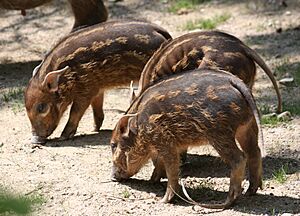
Red river hogs breed at certain times of the year. This means their young are born between the end of the dry season in February and the middle of the rainy season in July. A mother hog is pregnant for about 120 days.
Before giving birth, the mother builds a nest. She uses dead leaves and dry grass for this. She then gives birth to a litter of up to six piglets. Usually, three or four piglets are born at a time.
Newborn piglets weigh about 650 to 900 grams (1.4 to 2 pounds). They are dark brown with yellowish stripes and spots when they are born. They stop drinking their mother's milk after about four months. By about six months, they get their plain reddish adult fur. The dark marks on their face do not appear until they become adults, which is around two years old. Red river hogs probably live for about fifteen years in the wild.



